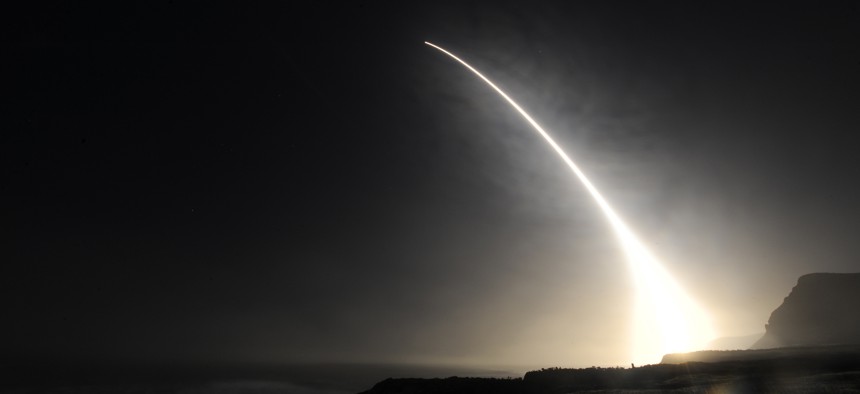
An unarmed Minuteman III intercontinental ballistic missile launches during an operational test at 11:34 p.m., Feb. 20, 2016, Vandenberg Air Force Base, Calif. U.S. Air Force Photo by Michael Peterson
Throwing Money at Missile Defense Won’t Fix It
We need a smarter, holistic approach that combines offense and defense.
Following the recent missile launches by Tehran and Pyongyang, some analysts have argued for an increase in the annual budget of the Missile Defense Agency (MDA). It is a predictable response, but it will not produce the desired effect – and not just because sequestration makes it difficult.
In November 2014, the then-heads of the Army and Navy wrote a memo titled “Adjusting the Ballistic Missile Defense Strategy,” in which they argued that the “current acquisition-based strategy is unsustainable in the current fiscal environment and favors forward deployment of assets in lieu of deterrence-based options to meet contingency demands.” That same year, the Center for Strategic and Budgetary Assessments noted that “barring technological breakthroughs, the competition in [missile defense and defensive space control] is currently heavily offense-dominant, and thus, ramping up expenditures in a likely futile attempt to actively defend it is a cost-imposing strategy on the United States.”
In essence: The combination of sequestration and a persistently unfavorable cost-intercept exchange ratio sets up a tyranny of numbers, in which a limited U.S. BMD system is forced to compete with the world’s growing and increasingly capable arsenal of ballistic missiles.
Increasing the number of interceptors at the Ground-based Midcourse Defense (GMD) will not negate this reality, nor will it improve the chances of intercepting an ICBM launched against the continental United States.
First, the GMD is too expensive. In 1998, the Clinton administration envisioned a National Missile Defense system of 250 Ground-based Interceptors (GBIs) by 2011. In 2000, the Congressional Budget Office estimated that this system would cost $48.8 billion to build and operate through 2015. Sixteen years and some $40 billion later, the current GMD consists of a mere 30 GBIs.
Second, the GMD is inefficient. Riddled with technical problems, the program has a dismal flight test record of nine successful intercepts in 17 attempts since 1999. The program’s two types of exoatmospheric kill vehicles include the CE-1, which failed its latest intercept test in July 2013 after a substantial refurbishing and retrofitting effort; and the CE-2, which intercepted its first target in June 2014 after failing its two previous attempts in January and December 2010. Neither has been tested against an ICBM-range target. Unsurprisingly, the Government Accountability Office concluded in its latest report that the “MDA has not proven GMD can defend the homeland.”
Introducing a new kill vehicle design will not fix the GMD. The MDA has to make the CE-1 and CE-2 EKVs work, to be able to compete with the threats of today, and not divert scarce resources in the pursuit of a possible technical solution five years down the road.
Other BMD systems, such as the Terminal High Altitude Area Defense (THAAD), AEGIS BMD, and the Patriot Advanced Capability (PAC), are facing an entirely different set of challenges. First, they have to be guarded or be able to defend themselves against non-ballistic missile threats, such as cruise missile attacks, rocket, artillery, and mortar, and unmanned aerial systems. Second, they need to become interoperable by pivoting toward an open architecture that can plug-and-fight, streamline command-and-control processes, and extent situational awareness. And third, they must be integrated in the Joint Force to increase their tactical and strategic utility on the battlefield. Overall, BMD deployments must become more flexible and mobile, with a greater emphasis on an intelligence-driven, rather than a global demand-driven, force posture.
Read more: Your Pocket Guide to How US Missile Defense Works
BMD can be harnessed and refined to win a prospective missile salvo competition, but it will never substitute for offensive nuclear and conventional capabilities. In the end, what counts is not the amount of missiles that are intercepted in the sky, but the number of enemy launching platforms that are destroyed during an exchange. As such, the military services are already laying the groundwork for a system-of-systems, the so-called Integrated Air and Missile Defense (IAMD). According to then-Chairman of the Joint Chiefs of Staff Gen. Dempsey, IAMD is an envisioned super-structure in which “all capabilities—defensive, passive, offensive, kinetic, non-kinetic—are melded into a comprehensive joint and combined force capable of preventing an adversary from effectively employing any of its offensive air and missile weapons.” In the context of IAMD, the Army is currently focusing on the Integrated Air and Missile Defense Battle Command System, the Navy has put forward the Navy Integrated Fire Control-Counter Air, and the Air Force is relying on an offensive counter-air posture in the absence of ground-based air defenses within the aviation branch.
IAMD is the smart way forward to shape the future Joint Force and apply a holistic approach to integrate offensive and defensive counter-air capabilities. And while bipartisan support in Congress for BMD is certainly good to have, spending billions on trying to overcome the tyranny of numbers is and remains a bad and outdated idea.